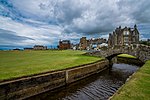St Andrews Ladies' Putting Club

St Andrews Ladies’ Putting Club, originally known as the St Andrews Ladies Golf Club when it was first established in 1867 for female golf players to use, now the club is also known as the Ladies’ Putting Club of St Andrews, or simply the Putting Club. The club is still a ladies only golf club based in St Andrews, Fife, Scotland. It is generally known to visitors as The Himalayas putting course, which is where the club's members and visitors play, and is thought to be the first minigolf course ever made. The Himalayas name comes about from the peaks and troughs on the course. It has both 9 and 18-hole courses, and is open to men, women and children (6 years of age and above) visitors alike for a nominal fee. The club is the world’s oldest ladies’ golf club.
Excerpt from the Wikipedia article St Andrews Ladies' Putting Club (License: CC BY-SA 3.0, Authors, Images).St Andrews Ladies' Putting Club
West Sands Road,
Geographical coordinates (GPS) Address Nearby Places Show on map
Geographical coordinates (GPS)
| Latitude | Longitude |
|---|---|
| N 56.3447 ° | E -2.8071 ° |
Address
Himalayas Putting Green
West Sands Road
KY16 9JE
Scotland, United Kingdom
Open on Google Maps








